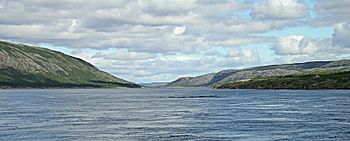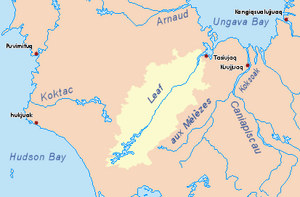Leaf River (Quebec) facts for kids
Quick facts for kids Leaf River |
|
|---|---|
 |
|
 |
|
| Other name(s) | Rivière aux Feuilles |
| Country | Canada |
| Province | Quebec |
| Region | Nord-du-Québec |
| Physical characteristics | |
| Main source | Lake Minto Nunavik 181 m (594 ft) 57°13′07″N 75°00′45″W / 57.21861°N 75.01250°W |
| River mouth | Leaf Bay (off Ungava Bay) Tasiujaq 0 m (0 ft) 58°46′37″N 70°04′00″W / 58.77694°N 70.06667°W |
| Length | 480 km (300 mi)(includes Lake Minto) |
| Basin features | |
| Basin size | 42,500 km2 (16,400 sq mi) |
The Leaf River is a big river in northern Quebec, Canada. Its French name is Rivière aux Feuilles. In the Inuktitut language, it's called Kuugaaluk, which means "the large river." It's also known as Itinniq, meaning "where there are spring tides."
This river is special because it's at the very edge of where trees can grow. It starts at Lake Minto and flows northeast. It travels through the Ungava Peninsula and empties into Leaf Bay, which is part of Ungava Bay. The river is about 480 kilometres (300 mi) long. Near where the river meets the bay, you'll find the Inuit community of Tasiujaq.
You can actually paddle down the entire Leaf River! It doesn't have any huge waterfalls or dangerous rapids that would stop you. The river is usually free of ice for about 60 days each year.
Contents
Rivers that Flow into the Leaf River
Many smaller rivers and streams join the Leaf River along its journey. These are called tributaries. Some of the important ones include:
- Charpentier River
- Nedlouc River
- Descareaux River
- Daunais River
- Goudalie River
- Vizien River
- Brissard River
- Qijuttuuk River
- Cohade River
- Tuktu River
- Dufreboy Creek
- Viennaux River
- Papijjusaq River
- Peladeau River
- Fanfan River
History of the Leaf River
People have known about the Leaf River by its English name since at least the late 1800s. It likely got its name from the Arctic willow and birch trees that grow along its banks. These trees are quite sparse there.
The Hudson's Bay Company used to fish for salmon and porpoises in the river. Around 1905, they even opened a trading post near its mouth. In the early 1900s, the French name Rivière des Feuilles was used. This name was officially changed to Rivière aux Feuilles in 1925.
Early Explorers
Here are some of the first known explorers who visited the Leaf River:
- 1898 - Albert Peter Low
- 1912 - Robert J. Flaherty
- 1976 - Bob Davis
The Leaf River Caribou Herd
The Leaf River is home to a very large group of caribou, called the Leaf River caribou herd (LRCH). These caribou are a special type that moves between forests and the open tundra. They are known for returning to the same areas near the Leaf River to have their babies.
This herd has changed in size over the years. In 1991, there were about 270,000 caribou. By 2001, this number grew to 628,000! However, a survey in 2011 by Quebec's Natural Resources and Wildlife showed the herd had decreased to 430,000 caribou. Scientists are studying these caribou. Some international studies suggest that the Leaf River herd might be at risk of disappearing by the year 2080 if their numbers keep dropping.
See also
 In Spanish: Rivière aux Feuilles para niños
In Spanish: Rivière aux Feuilles para niños



